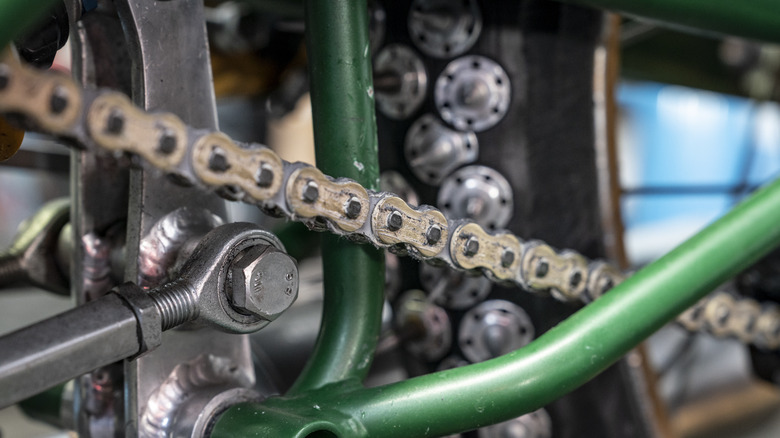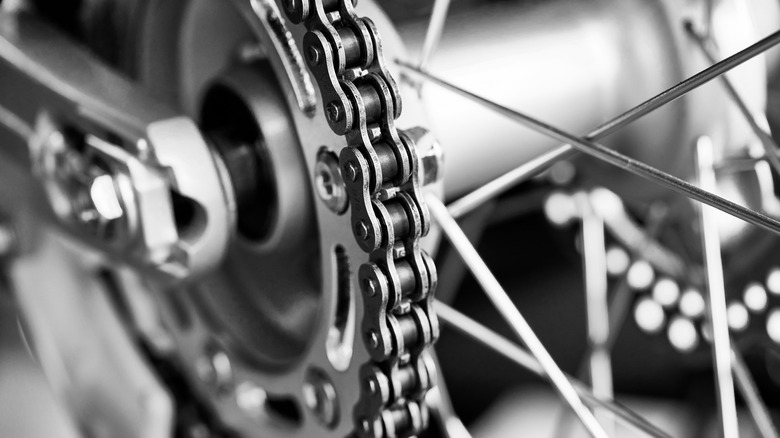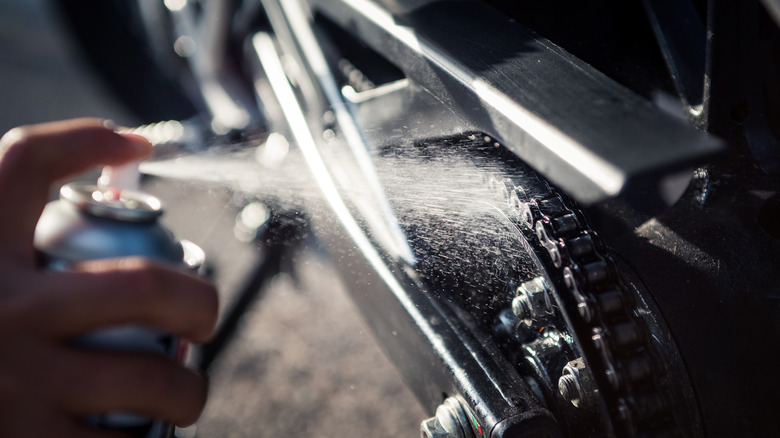How Often Should You Lube A Motorcycle Chain?
With motorcycle maintenance jobs such as lubricating the chain, knowing how to perform the task itself is only half the battle. It's perhaps even more difficult to determine how often you should lube your chain, to maximize the benefit and keep everything running at its best.
Ride Adventures notes that a typical guideline of every 500 miles or so traveled is a common recommendation for lubing your motorcycle chain. It's a job that should be performed after cleaning the chain for best results (anything from mud to lubrication from previous maintenance can cause wear on the chain if not cleared away first). With the two jobs being closely related, it makes sense that a chain subjected to more frequent use, which has an unsealed chain (usually on off-road machines or older motorcycles) or which often gets dirty should be cleaned and lubricated more often. Approximately every 300 or 600 miles is a good guideline, depending on these factors.
If your chain drive motorcycle gets extensive use, you might dedicate a lot of your time to treating your chain. Per PJ1, off-roaders should perhaps get into the habit of performing the ritual after returning each time they take their wheels out for a spin. The reasoning for this is twofold: Not only does it allow the rider to clear away the mud, grass, dust and anything else that an adventurous ride can result in, but it's best for the lube not to be applied straight before you head out.
The difference between a sealed and unsealed chain
Clearly, then, there's no definitive answer as to exactly how often you should lube your chain drive motorcycle. It's more a matter of keeping the guidelines in mind and tailoring your maintenance schedule to your specific vehicle's needs. To better understand them, it's important to know whether your motorcycle has a sealed or unsealed chain.
The crucial thing is that a sealed chain boasts seals made of rubber, a sort of built-in defense from drying out that keeps the original lube in circulation in the mechanism. Its unsealed counterpart is more exposed and lacks this in-built protection. Similarly to a sealed transmission, though, this doesn't mean that no servicing is ever needed for such a chain. The outer components of a sealed chain remain rather vulnerable, particularly if a rider frequently travels in adverse conditions. In a 2018 Ask MO Anything segment, an RK Chains representative explained, "The lubrication keeps the chain seals pliable so that they keep the internal lubrication in its place and keep dirt and debris out."
Riders should give them the best chance of doing just that, then. The presence of such seals is an easy way to identify that your motorcycle has a sealed chain, but this is also an indicator to be rather gentle with cleaning it: The seals can be quite delicate and the more they're worn or damaged the less effective they may be. Lastly, we'll take a look at the job itself.
An introduction to cleaning and lubricating your motorcycle chain
Aside from other associated jobs like ensuring your chain is as tight as it needs to be and adjusting it via the axel nut if it isn't, Cleaning a motorcycle chain can be crucial even with sealed chains (the O-Rings of which can accumulate a lot of harmful dirt if a rider isn't vigilant). As these rings are rather soft, it's vital to use appropriate cleaning products (manufacturers and other professionals can advise), but it needn't be a taxing maintenance job to complete. Carefully applying and spraying the product will remove any build-up and help prevent the rings being damaged and/or the chain rusting.
Following this up with the lubricant after a thorough drying is an excellent way to keep your chain in top condition, whether sealed or not. If you're unsure whether it's time to do just that, or which products to use, you can seek the advice of your mechanic.
It's easy to become complacent in the knowledge that a sealed motorcycle chain can care for itself to a certain extent, or to generally prioritize other components of your beloved bike. However, doing so can cause unsightly rusting and reduced performance, potentially putting you in danger. To help avoid that, lube and clean it as regularly as your usage would tend to indicate.


